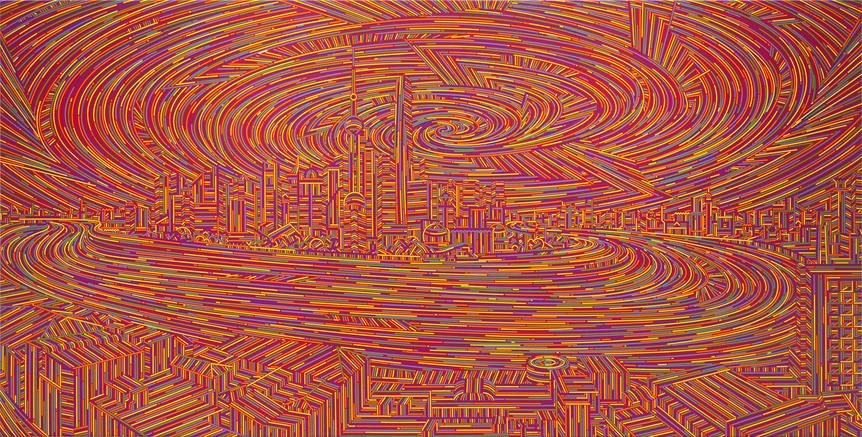-
From Current Issue
-
- Editor’s Letter Fire in the Heart
- Reviews I Gusti Ayu Kadek Murniasih
- Reviews 11th Seoul Mediacity Biennale: “One Escape at a Time”
- Dispatch Networked China
- One on One Monira Al Qadiri on Yukio Mishima
- Essays The rise of independent art spaces in pandemic-era Shanghai
- Features Tuan Andrew Nguyen
- Table of Contents
- Web Exclusives
- Archive
- Subscribe

R
E
V N
E
X
T
Installation view of LU XINJIAN’s “Boogie Woogie” at de Sarthe Gallery, Hong Kong, 2018. All images courtesy the artist and de Sarthe Gallery, Hong Kong / Beijing.
The colorful, kaleidoscopic patterns that fill the two canvases at the entrance of de Sarthe Gallery appear inscrutable at first glance. They can be a mass of thin tubes, a route map or even a maze. When one takes a few steps back, however, one can perhaps discern views of the titular sites in Hong Kong Central and HSBC (both 2018).
In a way, the metropolis does resemble a labyrinth: the closer one looks at it, the easier it is to get lost within it. This encapsulates Lu’s “Boogie Woogie,” the artist’s first solo exhibition in Hong Kong, showcasing 12 of his trademark cityscape paintings. The title of the show echoes Piet Mondrian’s Broadway Boogie Woogie (1942–43), painted at the time of his escape from Europe to the United States during World War II. He was fascinated by the Broadway dance, attempting to capture its “dynamic rhythm” through grids and lines. Influenced by Mondrian, Lu has adopted a similar strategy to depict the rhythm and energy of some of the largest cities in the world, from Shanghai and Hong Kong to Dubai and Sydney.
Spanning four meters across and taking up the largest wall of the gallery was Shanghai No. 14 (2018) from Lu’s “City Stream” series, featuring an abstract view of the Waitan District, with the Huangpu River weaving through the city center. The Oriental Pearl Tower erected on the bank is the most recognizable landmark in the painting, with its three iconic spheres and columns. The tower is surrounded by a dense cluster of offices, hotels and the Shanghai Aquarium, all pieced together bit by bit with thin acrylic lines in florescent red, orange and purple. The city’s continuous expansion is reflected in the two enormous swirls—one in the sky and the other on the ground—that separate the city center from the residential buildings at the bottom of the painting. Similarly, in Dubai No. 1 (2016), a black-and-white painting from the same series, the curved lines representing the city’s circular highways convey a sense of speed. The technologically augmented pace of city life is highlighted by the irregular shapes filling out the background, like tiny components in an urban machine.
While “City Stream” exhibits shiny, modern metropolises, the intriguing Jiang Nan No. 1 (2017) and No. 4 (2018) from Lu’s “Reflections” series, hanging at the other side of the gallery, explore an ancient Chinese water town in the eponymous area of southern China. No. 1
is a labyrinthine depiction of classical Chinese architecture, rendered in dense, parallel horizontal and vertical lines. Arrows and cryptic symbols replace the Chinese characters typically found on the circle plaques hanging on the eaves, suggesting a transformation from the traditional to the modern. Since rainy weather is frequent in southern China, the eaves of buildings often feature a waved design to allow water to slide off the roof more easily; in the painting, the eaves are represented by zigzagging curves, which is as perplexing as the staircase incongruously extending in between the buildings. Next to this mesmerizing work, No. 4 presents a mirrored image of a Jiang Nan bridge extending across the river, with people walking on and next to it. This is the only painting with people included in the landscape, revealing scenes of daily life in the area. In contrast to the frenzied activity shown in other paintings in the show, the Jiang Nan pieces give the impression of a slow-paced town.
By using grids and lines as basic units to illustrate the metropolis, Lu seems to suggest that cities around the world are becoming increasingly similar. The most striking differentiators are not skylines but colors—fluorescent hues conveying the bright lights of Shanghai and Hong Kong; copper tones reflecting ancient red-tinged Chinese architecture in Jiang Nan No. 4; and a nautical palette of navy and white hinting at the port city in Sydney Opera House (2015). “Boogie Woogie” offers a different perspective on urban landscapes through the use of digital image manipulation and the logic of geometry, while still capturing the ethos of the cities.
Pamela Wong is an editorial intern of ArtAsiaPacific.
Lu Xinjian’s “Boogie Woogie” is on view at de Sarthe Gallery, Hong Kong, until July 7, 2018.
To read more of ArtAsiaPacific’s articles, visit our Digital Library.









